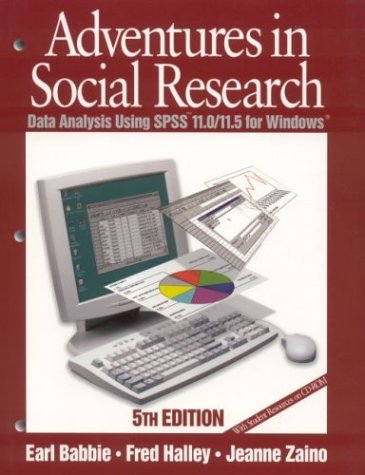Adventures in Social Research: Data Analysis Using Spss 11.0/11.5 for Windows 5th Edition
Babbie, Earl; Fred Halley; Jeanne Zaino
Vanderbilt University Press, Nashville
2003
0761987584
 This is an interesting addition to the growing list of publications claiming to integrate statistical theory with practice in terms of students' ability to use SPSS. It is an extensively set out book, which is also inexplicably hole punched and presented with an accompanying CD containing data sets.
The book claims from the outset to be set apart from other books because it aims 'to train students who will use computers rather than be used by them'. It is, however, not alone in making such claims, as Antonius (2003) and Foster (2001) both do.
This is an interesting addition to the growing list of publications claiming to integrate statistical theory with practice in terms of students' ability to use SPSS. It is an extensively set out book, which is also inexplicably hole punched and presented with an accompanying CD containing data sets.
The book claims from the outset to be set apart from other books because it aims 'to train students who will use computers rather than be used by them'. It is, however, not alone in making such claims, as Antonius (2003) and Foster (2001) both do.
The CD contains two useful data sets which have limited applicability because they can't be saved. I was also personally unable to download the data sets to my version 11 of SPSS This restricts its ongoing use in a classroom scenario unless every student has their own copy. An inevitable marketing ploy, of course, but disappointing to tutors who wish to give students useful 'real life' data sets to work with.
The book is set out in six parts: I: Preparing for Social Research; II: Getting Started; III: Univariate Analysis; IV: Bivariate Analysis; V: Multivariate Analysis and VI: The Adventure Continues. The structure can be argued to be a little illogical in that Part VI introduces students to defining and entering data in SPSS, something which most social scientists, and certainly teachers, realise is the students' first step in exploring any new learning package and particularly a potentially off-putting statistics package like SPSS. This information should appear much earlier in the book, I feel.
Another slightly misleading point made in Part I is where readers are encouraged to believe that the book can be used for earlier versions of SPSS (7.0 or higher) with the proviso that 'a few of the instructions, procedures and screens may be slightly different than those in the book'. Students, however, would struggle significantly to work with this book in SPSS Versions 7 to 9.
Chapter 2 within Part I of the book – The Theory and Process of Social Research – uses deprivation theory of church involvement as an example, but this is perhaps a little complicated for most social science students to use (although logically a specialist area for one of the authors). It may have been better to use more 'user-friendly' examples of variables such as poverty, income, housing or gender. There are also some examples where attitudes are examined resulting in theoretical outcomes. Here (e.g. p.15) the student could be enthused but cut off abruptly as this part of the chapter says 'we'll come back to this issue later to find out whether our expectations are correct'. It is safe to assume that students won't be reading this large book at one sitting, so better if the authors had pointed out which section will next cover this issue. It took me a while to find it.
Despite these reservations, this is a thorough and engaging book with relevant material, which can be further explored by students. The Review Questions at the end of each chapter are useful, less so the Key Terms.
In Chapter 4 (Part II), the section on Sampling is too short, however and students need to know more about this before starting the subsequent chapters on SPSS. Other theoretical material is covered more comprehensively in Chapters 1-4.
Some useful exercises for students to follow in Chapters 5-8 (Part III) are accompanied by clear and comprehensive instructions. Variables are explored in reasonable depth for the audience anticipated and the Suggestions for Further Analysis in Chapter 10 are also potentially useful. Chapter 13 (Part IV) is unfortunately titled 'What Causes Different Attitudes Towards Abortion?'. All social scientists are told from the beginning of their education that association does not equal causation, and the former is what this chapter examines, students could be forgiven for experiencing some confusion. The chapter does not discuss this issue in enough detail.
Nevertheless the Lab Exercises provided at the end of some chapters encourage students to carry out further analysis, and these could be effectively managed in a classroom environment.
Chapter 14 (Part IV) - Measures of Association - is very thorough in its theoretical exploration of the tests employed, before utilising practical examples and this is perhaps one of the things that sets the book apart from others in a positive way. There is no doubt that if students do follow this book to the end, completing all the exercises, they will have a very thorough knowledge of the practical workings of SPSS. The key to the effective use of the publication, however, will be its ease of application by tutors to classroom environment, which has its limitations as reviewed above.
References
ANTONIUS R (2003) Interpreting Quantitative Data with SPSS, Sage: London.FOSTER J J (2001) Data Analysis: Using SPSS for Windows, Sage: London.
Gill Gillespie
Northumbria University

